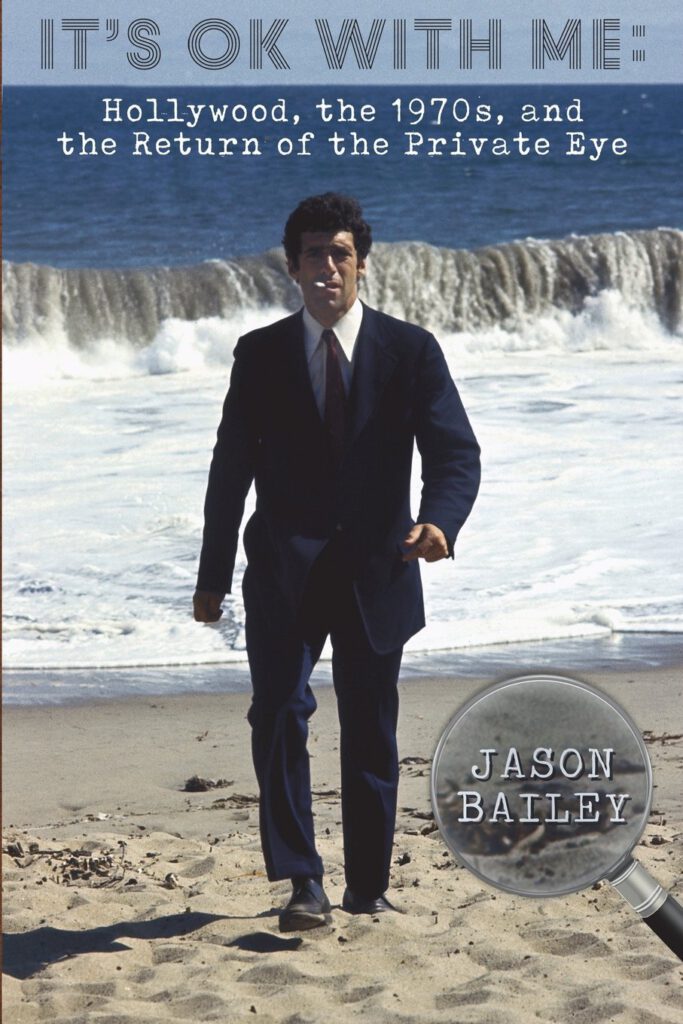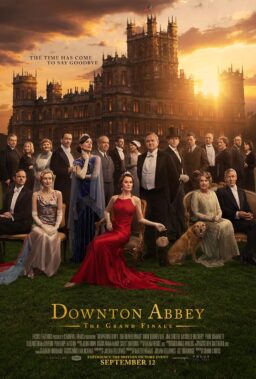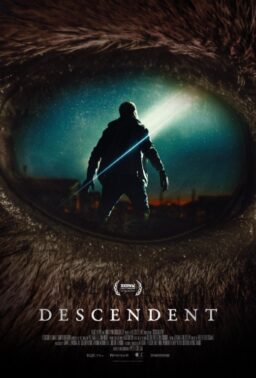We’re proud to present an excerpt from a new book by Jason Bailey, “It’s Okay With Me: Hollywood, The 1970s, and the Return of the Private Eye.”
Synopsis (from Amazon.com): One of the cornerstones of the 1970s New Hollywood movement was the reinvention of genres from the studio era, with Westerns, musicals, and gangster movies getting the “revisionist” treatment by the so-called Film Brats who were raised on them. But few genres were revisited with as much vigor as the private eye movie – which found New Hollywood icons like Robert Altman, Roman Polanski, and Arthur Penn putting their distinctive spin on the timeworn conventions of the gumshoe film. So what was it about the private eye movie that was so compelling at that particular juncture, in both film history and American life? In It’s Okay With Me, author Jason Bailey dives deep into the essential detective pictures of the era, breaking down how they bridged past and present, while examining how each film was not only representative of New Hollywood, but of the wider cultural moment.
“At first I said, I don’t want to do Raymond Chandler,” Robert Altman recalled, of the initial offer to direct the 1973 film version of The Long Goodbye. “If you say ‘Philip Marlowe,’ people just think of Humphrey Bogart.” But when Gould’s name was floated, “then I was interested. So I read Leigh Brackett’s script, and in her version, in the last scene, Marlowe pulled out his gun and killed his best friend, Terry Lennox. It was so out of character for Marlowe, I said, ‘I’ll do the picture, but you cannot change that ending! It must be in the contract.’ They all agreed, which was very surprising. If she hadn’t written that ending, I guarantee I wouldn’t have done it.”
Brackett’s participation was a key link to the character’s past – her second screenwriting credit, shared with William Faulkner and Jules Furthman, was for Hawks’ Big Sleep. “I met Chandler only once,” Brackett said. “I know he wanted Marlowe to be depicted as an honest man, and somebody who was his own man. I wanted to get that into the screenplay. But I also had to show Marlowe the way he looks to us now in the Seventies… Because Marlowe, as Chandler saw him, would be unthinkable in the Seventies.” Altman agreed: “I think it’s a goodbye to that genre – a genre that I don’t think is going to be acceptable anymore.” To convey that displacement, Altman and Brackett hit upon their guiding principle. “I decided we were going to call him Rip Van Marlowe,” Altman said, “as if he’d been asleep for twenty years, had woken up and was wandering through this landscape of the early 1970s but trying to invoke the morals of a previous era.”
To drive the point home, Altman starts the film with Gould’s Marlowe literally waking up from a deep sleep. These opening shots are the only time he’s not in a full suit, which he even wears to take out his laundry. Throughout the picture, he’s the only one wearing a tie (even the gangsters are in turtlenecks), and he only removes it when he goes into the ocean (though he leaves his coat on). Marlowe’s the only one smoking – and he’s doing it constantly – the “Marlboro Man” sticking out like a sore thumb in the New Age, health-conscious enclave of Malibu. (He doesn’t stop smoking until the very end, when he needs that hand for his gun.)
The world has changed around him: his neighbors are naked yoga flower children, his cellmate is a chatty revolutionary, and he finds his missing person in a smiley/happy rehab facility. But this Marlowe is a walking anachronism – he just keeps smoking his cigarettes, tying his tie, and doing his job. He is surrounded by his time, yet he is not of it.
“He is a knight errant, and like Don Quixote imperfectly understands the world he inhabits,” Roger Ebert wrote of Gould’s Marlowe, noting that, in contrast to the sardonic narrators of the earlier Chandler pictures, his is a “meandering dialogue that plays as a bemused commentary to himself.” And perhaps he is, though “to himself” seems too purposeful a description for this Marlowe’s sideways mumble, which is less Bogart than W.C. Fields – and seems to point the way towards another muttering Altman protagonist, Robin Williams’ Popeye. His frustrated asides (“Boy, that cockamamie cat”) and nonplussed reactions (“Why don’tcha go over there and tell the girls they’ll catch a cold”) seem a coping mechanism, a way of at least amusing himself in a world where nothing else makes sense.
Altman’s refusal to play by the rules is made clear right from the jump, as he spends no less than eleven minutes on an opening sequence in which Marlowe goes on a late-night grocery store run to feed his finicky cat. It could just be one of Altman’s oddball touches, like the unexplained baby shoe in Marlowe’s apartment or the inexplicable carnival photo booth that takes his mug shot; maybe it’s just a character beat, establishing the proper anything-goes mood. But author William Luhr positions it as a miniature version of the complex mystery that follows, in which Marlowe shuttles his pal Terry Lennox off to Mexico, is accused of assisting in Terry’s murder of his wife, is hired to track down drunken, suicidal Hemingway-esque author Roger Wade, and ends up discovering (wouldn’t ya know it) that his two cases are connected. Yet in both the cat food jaunt and the Lennox/Wade mystery, Luhr argues, “empty characters and empty actions begin and end with Marlowe alone, feeling betrayed, and without the resources to understand or to cope with his situation.”
The opening sequence is one of three that comes up most often in discussions, both laudatory and critical, of The Long Goodbye, along with gangster Marty Alexander smashing a Coke bottle on his mistress’s face (a brutal echo of James Cagney and his grapefruit) and the surprise ending. All three scenes, significantly, are nowhere to be found in Chandler’s source novel, and anyone approaching the film looking for straight adaptation will find little to hold on to. Even casual viewers will likely find its borderline perverse visual style – with the camera in constant motion via zooms, dolleys, pans, and shifting focal points – disorienting or even off-putting. (Cinematographer Vilmos Zsigmond also inserts an extra dose of smoggy California haze by “flashing” the negative.) But these flourishes give the picture the wild, improvisational feel of a free-form jazz number – Altman as Mingus. More importantly, it’s of a piece with the storytelling; Marlowe cannot figure out his place in this world, and Altman never lets him (or, consequently, us) settle comfortably into his surroundings.
And as a result, it’s hard not to notice that Marlowe isn’t much of a detective. The payoff of his unsuccessful 3am cat food run is that he can’t even fool his own pet. When Terry Lennox arrives shortly thereafter, they pay “liar’s poker” – and Marlowe loses, an apt metaphor for the adventure to follow, in which he pledges constant allegiance to his friend, a conniving murderer who has exploited that friendship. The lug who gives Marlowe a lift home from jail puts it bluntly: “Sorry, Marlowe. Sorry you’re so stupid.” Other movies have their detective stumble around a bit, as is necessary to preserve the suspense of their mysteries; this one explicitly calls its hero dumb, and takes its time disproving the thesis.
Yet even this sap eventually wises up. When a drunken Marlowe presses Wade’s wife for the truth about his suicide, the mumble disappears; when he asks her, “Are you gonna tell me what really happened here,” he speaks plainly and clearly. Most people slur their speech when they’re drunk. Marlowe stops slurring. (Is it an affectation? Something to keep people off-guard?) When he chases her car down a busy street and she strangely ignores him, his sense of self is finally reignited – he plays the fool, but he will not be played for a fool. He finds the supposedly dead Terry luxuriating in Mexico and waiting for his newly single mistress Ellen Wade; Terry grins, “I guess if anybody was gonna track me down, it’d be you,” but he certainly doesn’t seem concerned about betraying his friend, or the consequence of that betrayal. Confronted with his crimes, Terry is unmoved. “What the hell, nobody cares,” he shrugs (a key concluding statement of Hickey & Boggs the previous year).
“Yeah, nobody cares but me,” Marlowe replies.
“That’s you, Marlowe,” Terry says. “You’ll never learn. You’re a born loser.”
“Yeah, I even lost my cat.” And with that, Marlowe shoots the fucker dead.
It’s a shocking, repugnant, and glorious moment, all at once – a “fuck you” to not only the customary hero code of the private eye movie, but the easy-come-easy-go spirit of the character until that moment. Throughout the film, he is passive in both action and in attitude; Terry’s “What the hell, nobody cares” isn’t that far removed from Marlowe’s own refrain of “It’s okay with me,” except that he’s finally encountered something that’s not okay. It’s the moment at which his anachronistic hero becomes, at long last, the modern man – evening the score for a personal slight, and thus philosophically equipped for the “Me Generation.” The ending doesn’t make him a better man; many would argue (and did, loudly, following the picture’s release) that it makes him a lesser one. But it certainly makes him a man of his time.
Considering its unconventional approach and unapologetic torching of genre norms, it shouldn’t come as a surprise that critics and audiences greeted The Long Goodbye with such hostility. It premiered at one of critic Judith Crist’s famed Terrytown weekends (fictionalized and immortalized in Woody Allen’s Stardust Memories) in perhaps the worst possible circumstances: following screenings of all the previous Marlowe pictures. West Coast critics fumed; Variety dubbed it “an uneven mixture of insider satire on the gumshoe film genre, gratuitous brutality, and sledgehammer whimsy,” while the Los Angeles Times’ Charles Champlin called Gould’s Marlowe “an untidy, unshaven, semi-literate dimwit slob who could not locate a missing skyscraper and would be refused service at a hot dog stand,” and sneered, “He is not Chandler’s Marlowe, or mine, and I can’t find him interesting, sympathetic or amusing, and I can’t be sure who will.” Kenneth Turan (also later of the Times) included it on a late-‘70s list of the worst movies ever made.
Box office was bad in its initial Los Angeles engagements, and runs in Chicago, Philadelphia, and Miami were likewise disappointing. Its New York premiere was cancelled at the eleventh hour, even though press screenings had already been held, and it was withdrawn from release nationwide. Rumors circulated that it would be re-edited, shortened, or abandoned altogether; it turned out, United Artists had re-jiggered its marketing campaign, torpedoing the initial posters and ads, which framed it as a straight thriller, for new posters by Mad magazine illustrator Jack Davis, which made it look like a madcap comedy. Opening in New York months later, it was a modest hit, championed by the New Yorker’s Pauline Kael (“Altman, who probably works closer to his unconscious than any other American director, tells a detective story, all right, but he does it through a spree—a high-flying rap on Chandler and the movies and that Los Angeles sickness”) and the New York Times’ Vincent Canby, who put it on the paper’s year-end top 10 list and praised its creators for having “the courage to create an original character and almost an original story that, by being original, does more to honor Chandler’s skills than would any attempt to make a forties movie today.”
But Farewell, My Lovely, a much more faithful Marlowe picture (with Robert Mitchum taking on the role) released two years later, was a much bigger commercial and critical success. By preferring that traditional appreciation to the tart aftertaste of Long Goodbye, contemporary critics were letting their own notion of nostalgia gloss over the blackness at the heart of true noir. That view, Luhr writes, “belies an understanding of the profoundly anti-nostalgic, anti-sentimental cynicism and despair that pervaded the actual films themselves, as well as The Long Goodbye.”
Films like Farewell, My Lovely regarded private eyes shallowly, refusing to wrestle with what a character like Marlowe truly meant in this era. It was easier to slap a trenchcoat on him, to put him in a window covered in streaming rain to a saxophone theme, and let us stash him in the past. Farewell was safe, a museum piece, a humorless presentation of fixed images, while the variation Altman presented was unbalancing – in his words, in his actions, even in the way his director framed him – and viewers resisted. “I suspect that people are reluctant to say goodbye to the old sweet bull of the Bogart Marlowe because it satisfies a deep need,” Kael wrote. “They’ve been accepting the I-look-out-for-No. 1 tough guys of recent films, but maybe they’re scared to laugh at Gould’s out-of-it Marlowe because that would lose them their Bogart icon. At the moment, the shared pop culture of the audience may be all that people feel they have left.” And that tension – between who was onscreen and what we needed them to be – would only pull tighter as the decade continued.
“It’s Okay With Me: Hollywood, The 1970s, and the Return of the Private Eye” is available now in paperback and Kindle editions.











